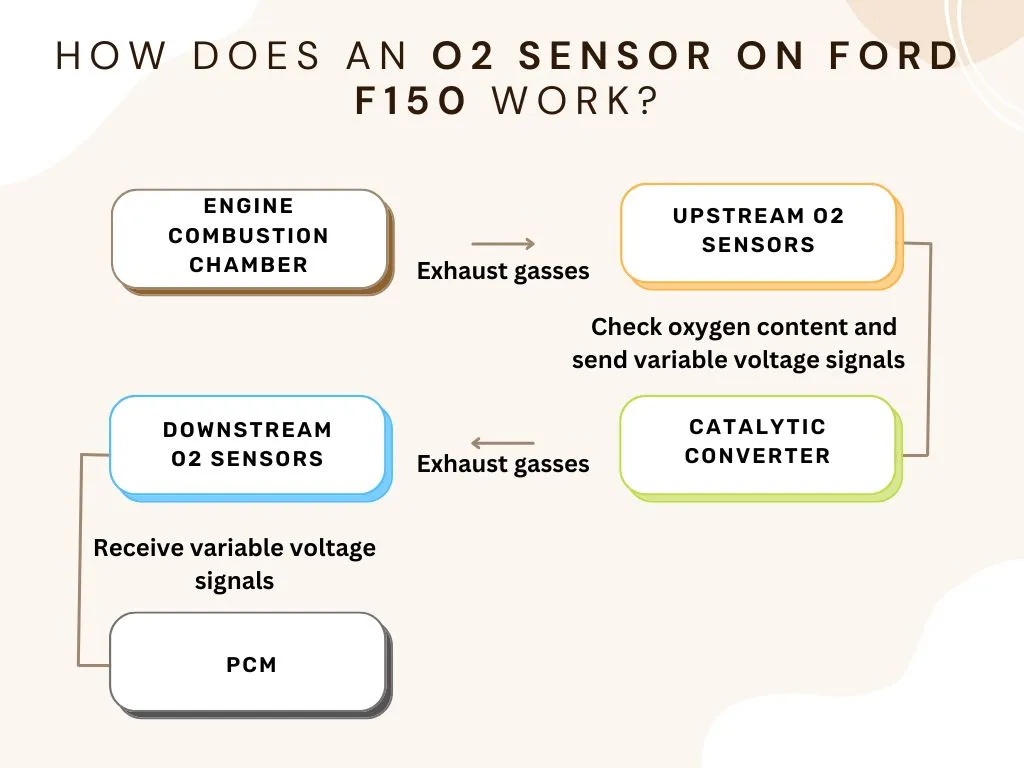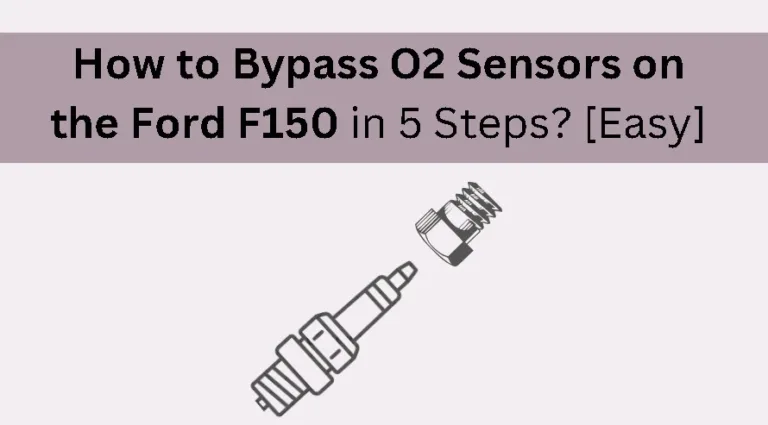The Ford F150 O2 sensor is a tiny metal plug that fits on the catalytic converter and helps the car’s computer detect the air/fuel ratio. This way the car ensures that the engine works decently with no inner issues to maintain its performance.
In F150 cars, you’ll find upstream and downstream O2 sensors based on the bank’s position. If you have no idea about the oxygen sensor in an F150 car, this guide will help you.
Here, I’ll share what exactly this component is, how it works, some signs of a malfunctioning O2 sensor, how you can locate it, and other information that should help.
Table of Contents
What Is Ford F150 O2 Sensor?
Just like other Ford O2 sensors, the F150 cars do come with these. They are a small (similar to spark plug) device that just monitors the air or fuel level in the cat converters.

Its main job is to detect and send signals to the PCM to alert the level of pollutants in the system before any parts get damaged.
With this, the car’s engine can crank better and ensure that the fuel is burning properly to give the right performance on the road.
How Does an O2 Sensor on Ford F150 Cars Work?
The O2 sensors F150 are powered straight from the Powertrain Control Module (PCM) and they have no fuse. To understand they work, here’s the detail along with a diagram:

- To begin with, the engine’s combustion chamber sends exhaust gases to the upstream O2 sensors. It’s the F150 O2 sensor bank 2 sensor 1 and bank 1 sensor 1. The location of the O2 sensor Ford F150 is near the cat converter.
- After that, the O2 sensor bank 2 sensor 1 F150 along with bank 1 sensor 1 detects the O2 level in the exhaust gases. Then, they send variable voltage signals to the car’s catalytic converters.
- Next, the cat converter starts working and sends the exhaust gases to lessen emissions. It is located between the upstream and downstream O2 sensors.
- Now, the downstream O2 sensors aka the bank 2 sensor 2 and bank 1 sensor 2 monitor the O2 level in the exhaust gasses. After that, they deliver variable voltage signals to the PCM.
- Once it’s done, the Powertrain Control Module (PCM) gets the variable voltage signals from both upstream and downstream O2 sensors.
- Then, the Electronic Control Unit (ECM) starts to adjust the air/fuel ratio and detect the catalytic converter efficiency.
That’s how the 2004 F150 O2 sensor or above model works! If the PCM doesn’t receive the signals, it’ll start showing the error code on the dashboard or turn on the CEL light.
What Are the Symptoms of a Bad O2 Sensor on Ford F150?
There are a few signs of a bad or problematic Ford F-150 O2 sensor 1 or 2 in bank 1 and bank 2. Here’s how you can detect it yourself:
- The car suddenly starts to use more fuel.
- You find the car seems to smell badly similar to sulfur or rotten egg.
- The powertrain runs poorly.
- You see the CEL light turn on and an error code.
- The exhaust flows black or dark greyish smoke.
- Your car’s engine cranks but doesn’t start or show power surges.
- The emission levels start to reach high.
Ford F150 O2 Sensor Location!
You’ll find 2 kinds of the O2 sensors in your car. One is the upstream sensor and another is the downstream one. Let me break down the F150 O2 sensor location below:
- Upstream O2 Sensors: Also known as the bank 1 and 2 sensor 1 device. These are closer to where the engine sends out exhaust gases and are placed under the manifold flanges and above the front cat converter (left and right side).
- Downstream O2 Sensors: Also known as the bank 1 and 2 sensor 2 device. These are placed in the tailpipe where the exhaust comes out, right behind the rear car converters (left and right side).
However, the 2010 Ford F150 O2 sensor location is also diverse than the given detail. You’ll find the 4 sensors in the middle (2x) and above (2x) the left and right cat converters.
On the other hand, the 2016 F150 3.5 Ecoboost O2 sensor location is a little different as it has bank 1 with sensor 3 in the rear of the car. You can easily find all sensors on the front-left, front-right, and rear-middle catalytic converter’s tailpipe.
For that reason, it’s always best to check the service manual to know the exact location of the O2 sensors.
Ford F150 O2 Sensor Replacement Cost!
To change the O2 sensor Ford F150, you should know exactly how much will it cost if done by an expert or yourself. Here’s the detail:
Via Ford Service Center
- 1990 to 2002 Ford F150 O2 Sensor: For the older F150 cars, it will cost no more than $170 to $200 to change the O2 sensor.
- 2003 to 2004 Ford F150 O2 Sensor: You’ll need to pay less than $250 to replace the 03 – 04 F150 O2 sensor by an expert.
- 2005 Ford F150 O2 Sensor: This will cost around $250 to $275 to change the O2 sensor in the 2005 F150 car.
- 2006 to 2010 F150 O2 Sensor: It may cost no more than $275 to $300 to change the 2006 – 2010 Ford F150 O2 sensor via the service center.
- 2011 to 2013 F150 O2 Sensor: To change the O2 sensor, it’ll take around $300 or more for the 2011 – 2013 Ford F150 O2 sensor.
- 2014 to 2015 F150 O2 Sensor: For the 2014 – 2015 F150 cars, the dealer will charge up to $400 to change the O2 sensor.
- 2016 to 2018 F150 O2 Sensor: To replace the O2 sensor of your 2016 – 2018 F150 car, it’ll cost between $362 and $412 or more.
- 2019 to 2023 or Above F150 O2 Sensor: If you own the latest F150 car, it may cost more than previous models, ranging from $400 to $500.
Note: Based on the labor charge in the service center, the cost of changing the O2 sensor on your F150 can rise or decrease.
Via Yourself
If you replace the O2 sensor on your F150 car (no matter what model), it’ll cost no more than $50 to $75 for the part.
Apart from that, you may need a wrench to unplug the sensor from the cat converter’s frame and a transmission jack to lift the car up.
How to Replace F150 O2 Sensor?
- Firstly, take off the negative cable with a minus sign from the car’s battery.
- Then, raise the car with a transmission jackstand.
- After that, get under the car and locate the O2 sensors.
- Next, unplug the O2 sensor’s wire and then itself. To do that, you can use an O2 sensor socket or wrench. If it’s stuck, spray some lubricant on the threads and let it soak in before trying again.
- Afterward, put some grease on the threads of the new oxygen sensor. Based on Haynes, this makes it easier to remove in the future.
- Once it’s done, tighten the sensor well using a wrench. Then, do the same thing for replacing other sensors if needed.
Overall Thoughts
Taking care of your Ford F150 O2 sensor is essential to ensure no harm to the engine or car’s catalytic converter. And, be sure to inspect the sensors once every 100k miles for the latest F150 and 50k to 70k for older cars.
I hope you enjoy this guide and that it helps you to know the ins and outs of the F150 O2 sensor. Catch You Later!




